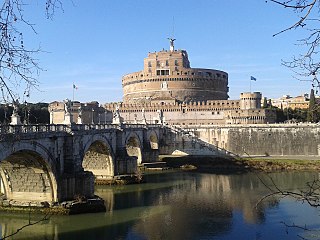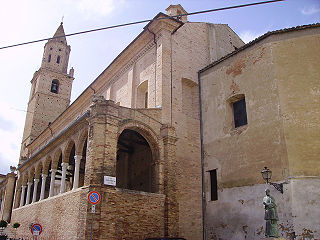Description
The church is located in the core of the ancient Greek-Roman city: it takes its name from the Egyptian Nile, which was venerated here by the Egyptian merchants. It was begun in 1385 as a chapel, dedicated to Sts. Angel and Mark, by will of cardinal Rainaldo Brancacci, whose family had a palace nearby. The current appearance dates from a 1709 rebuilding, under the direction of Arcangelo Guglielmelli. Remains of the original Catalan-Gothic structure include the main portal, with an architrave featuring angels, and a fresco in the lunette with The Virgin Mary and Saints Michael and Baculus with Cardinal Brancaccio (15th century). A sculpture of St. Michael from another portal has been moved in the interior.
Artworks in the interior include the tomb of cardinal Brancaccio, canvasses from Luca Giordano school, a 16th-century altarpiece by the Sienese painter Marco Pino and a marble tabernacle in the sacristy.
Antonio Valente, the first major keyboard composer of the Neapolitan school, was organist here in 1565–80.

Luca Giordano was an Italian late-Baroque painter and printmaker in etching. Fluent and decorative, he worked successfully in Naples and Rome, Florence, and Venice, before spending a decade in Spain.

The Mausoleum of Hadrian, usually known as Castel Sant'Angelo, is a towering cylindrical building in Parco Adriano, Rome, Italy. It was initially commissioned by the Roman Emperor Hadrian as a mausoleum for himself and his family. The building was later used by the popes as a fortress and castle, and is now a museum. The structure was once the tallest building in Rome.

Monte Sant'Angelo is a town and comune of Apulia, southern Italy, in the province of Foggia, on the southern slopes of Monte Gargano.

Francesco Solimena was a prolific Italian painter of the Baroque era, one of an established family of painters and draughtsmen.

Alife is a town and comune in the Province of Caserta (Campania), Italy. It is located in the Volturno valley, and is a flourishing centre of agricultural production. The comune was formerly inhabited by Arbëreshë and Jewish communities, who have since assimilated.

Giugliano in Campania, also known simply as Giugliano, is a city and comune in the Metropolitan City of Naples, Campania, Italy. As of 2017, it had some 124,000 inhabitants, making it the most populated Italian city that is not a provincial capital.

Città Sant'Angelo is a city and comune in the province of Pescara, Abruzzo, Italy.

San Francesco di Paola is a prominent church located to the west in Piazza del Plebiscito, the main square of Naples, Italy.

The Tomb of Antipope John XXIII is the marble-and-bronze tomb monument of Antipope John XXIII, created by Donatello and Michelozzo for the Florence Baptistry adjacent to the Duomo. It was commissioned by the executors of Cossa's will after his death on December 22, 1419 and completed during the 1420s, establishing it as one of the early landmarks of Renaissance Florence. According to Ferdinand Gregorovius, the tomb is "at once the sepulchre of the Great Schism in the church and the last papal tomb which is outside Rome itself".

Rinaldo Brancaccio was an Italian cardinal from the 14th and 15th century, during the Western Schism. Other members of his family were also created cardinals: Landolfo Brancaccio (1294); Niccolò Brancaccio, pseudocardinal of Antipope Clement VII (1378); Ludovico Bonito (1408); Tommaso Brancaccio (1411); Francesco Maria Brancaccio (1633) and Stefano Brancaccio (1681). He was called the Cardinal Brancaccio.

The Tomb of Cardinal Rainaldo Brancacci is a sculptural work in the church of Sant'Angelo a Nilo in Naples, southern Italy, executed by Donatello and Michelozzo around 1426-1428. Built in marble, partly gilt and polychrome, it has a height of 11.60 meters and a width of 4.60.
Santa Maria Assunta dei Pignatelli is a deconsecrated Roman Catholic church located at the end of Via Nilo in Naples, region of Campania, Italy. In the small piazza in front of the church is an ancient Roman statue of the Nile God.

Santa Maria Egiziaca a Forcella is a Baroque-style, Roman Catholic church located in the quartiere di Forcella, in the city of Naples, Italy;

The Catacombs of Saint Gaudiosus are underground paleo-Christian burial sites, located in the northern area of the city of Naples.

Sant'Angelo a Segno, NaplesSant’Angelo a Segno or Sant’Archangelo a Segno is a Roman Catholic church in Naples, Italy, located on Via dei Tribunali number 45.
Landolfo Brancaccio was a Neapolitan aristocrat, friend of King Charles II of Naples, and Roman Catholic Cardinal.

Santa Maria Egiziaca a Pizzofalcone is a Baroque-style, Roman Catholic, Basilica church on the street of the titular name in the hill of Pizzofalcone, in the historic center of Naples, region of Campania, Italy. The church layout was initially designed by Cosimo Fanzago.
San Michele Arcangelo is a baroque-style Roman Catholic church located on Largo Vinci #3 in Fermo, province of Fermo, in the region of Marche, Italy.

The Palazzo di Sangro di Casacalenda is an 18th-century aristocratic palace located across a piazza from the church of San Domenico Maggiore in central Naples, region of Campania, Italy. The East flank of the facade faces the facade of the church of Sant'Angelo a Nilo.
Cancelieri is a surname of Itlaian origin. Notable people with this surname include:


















